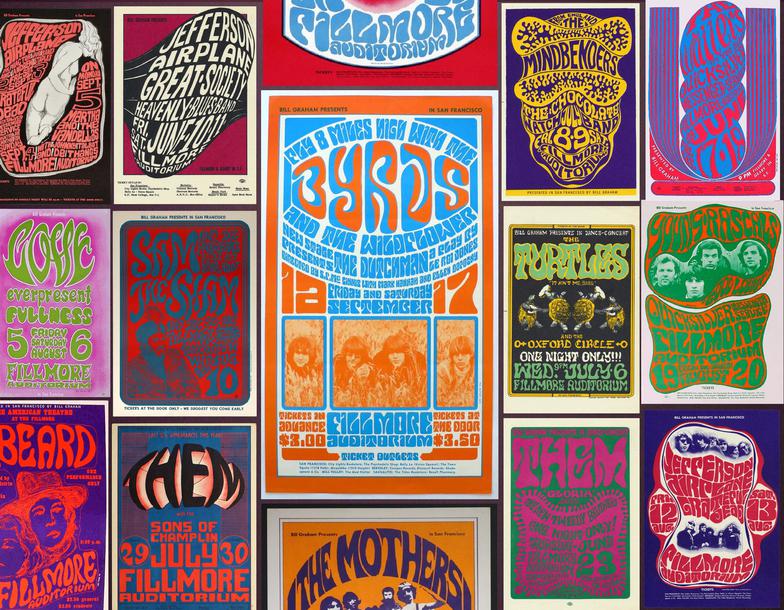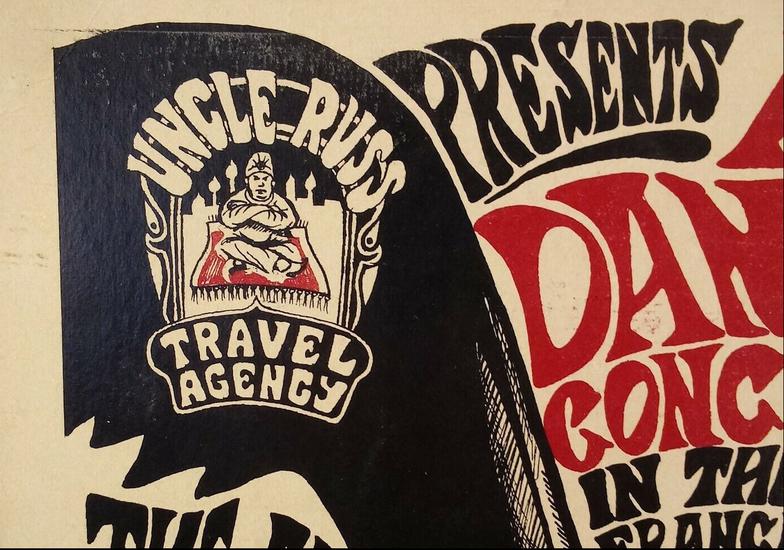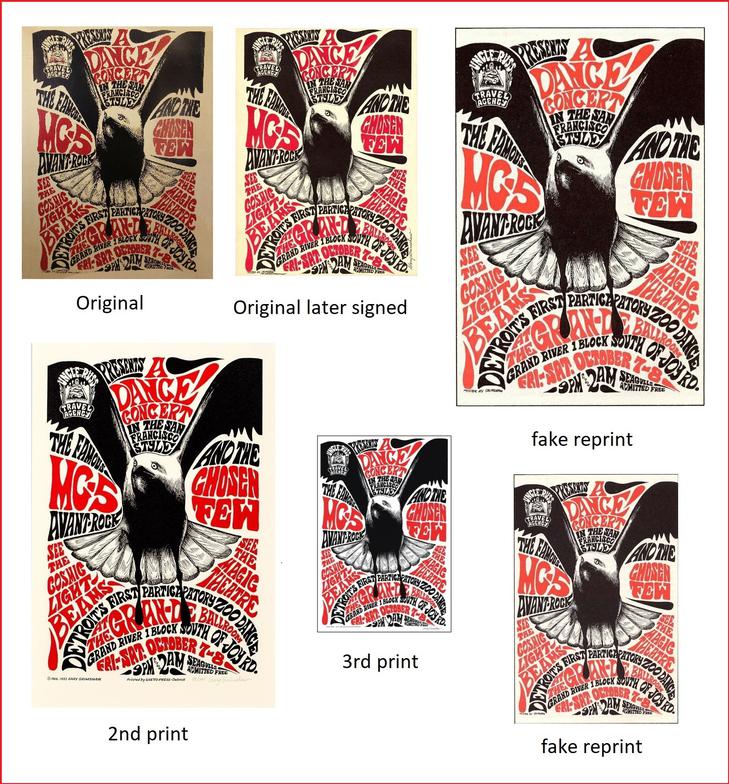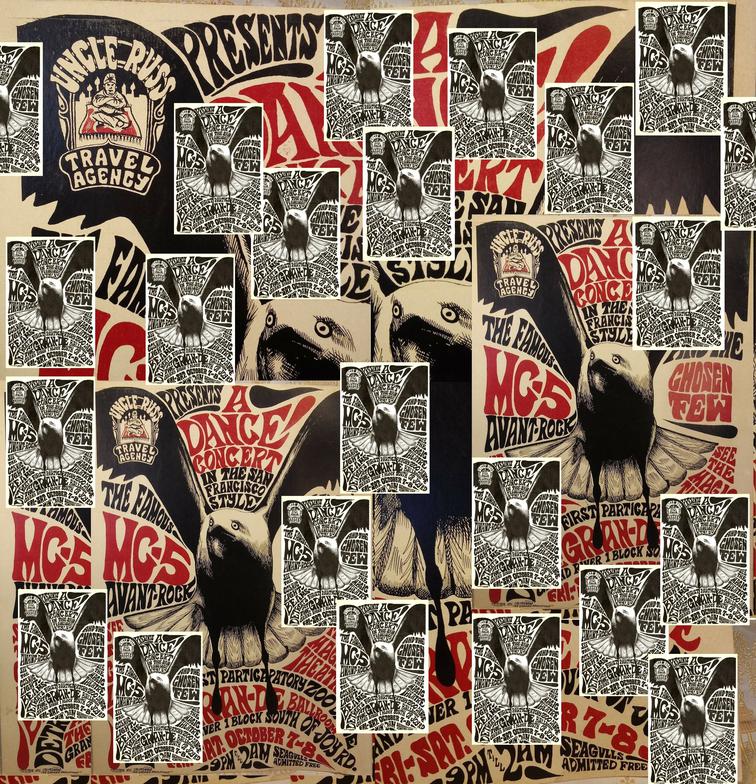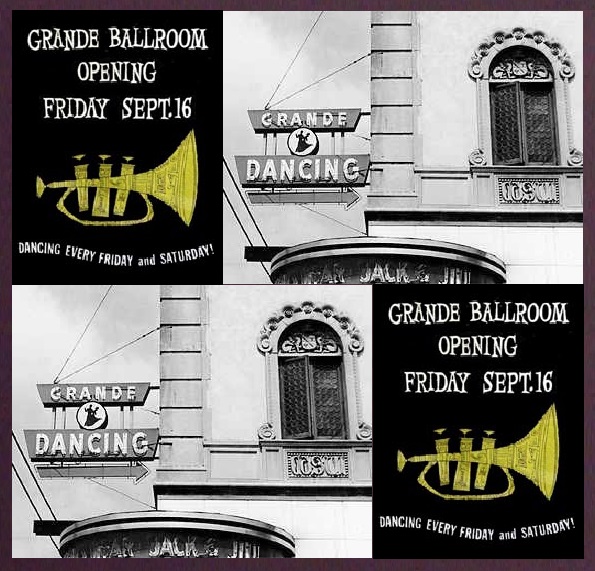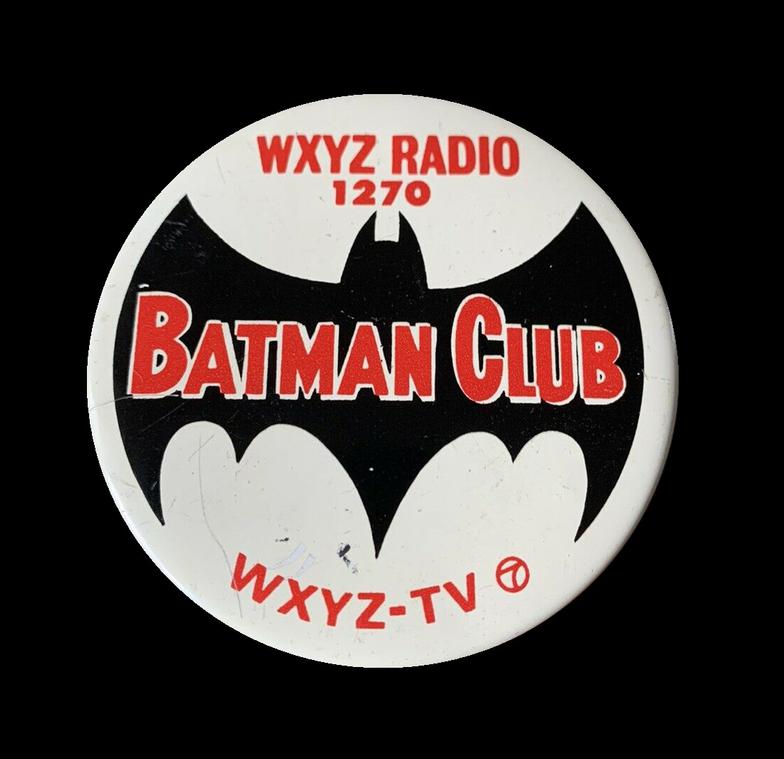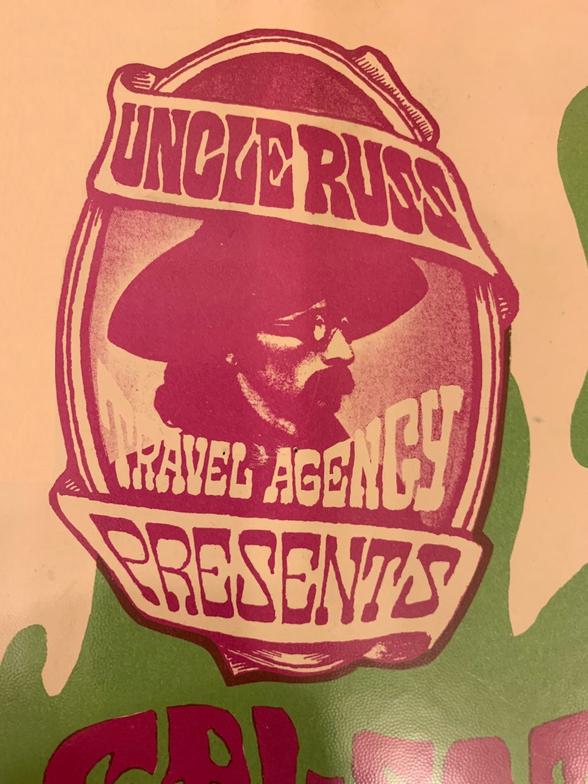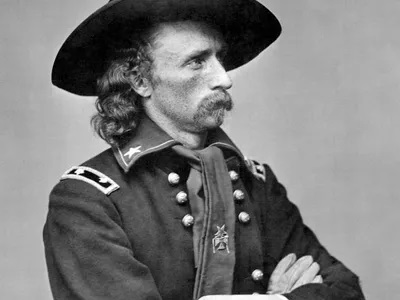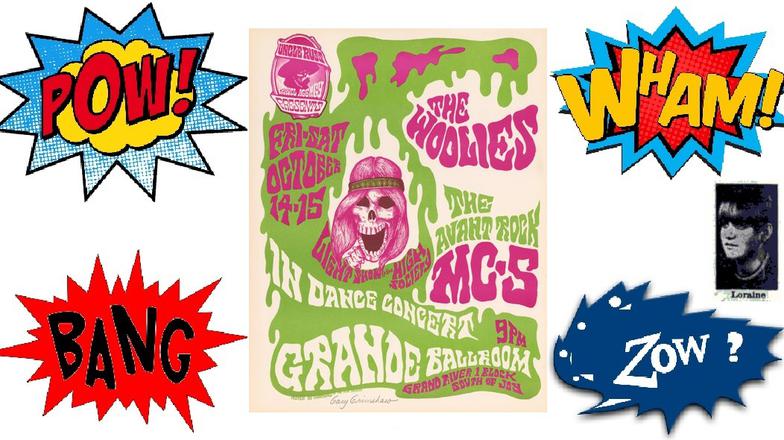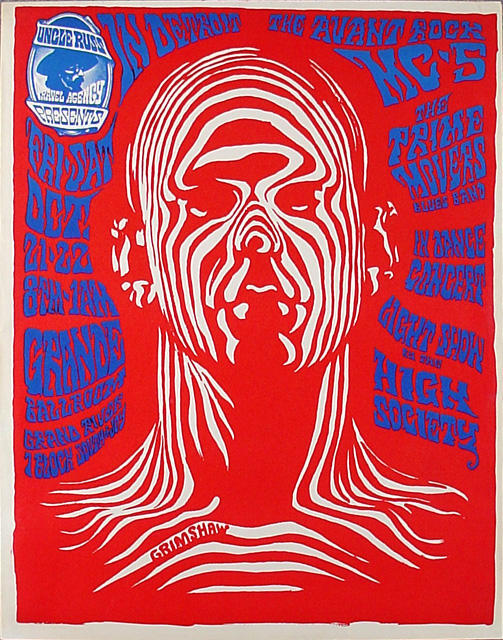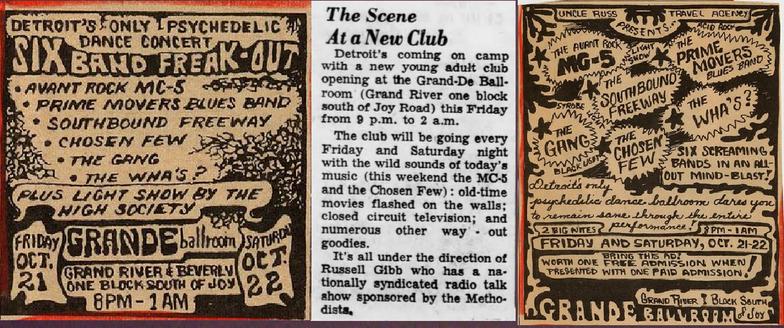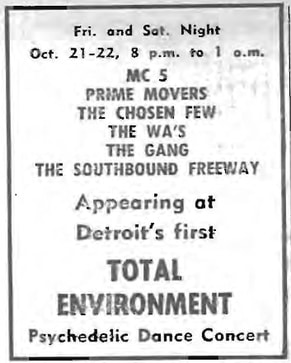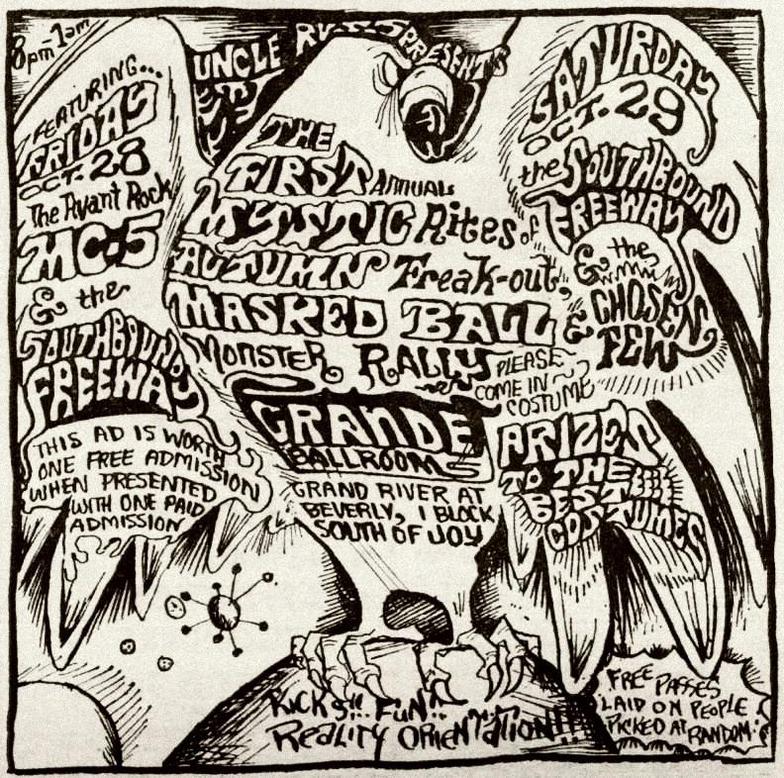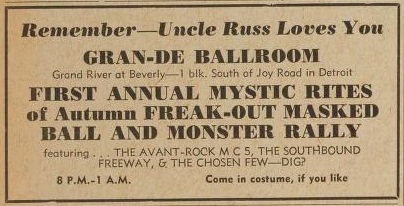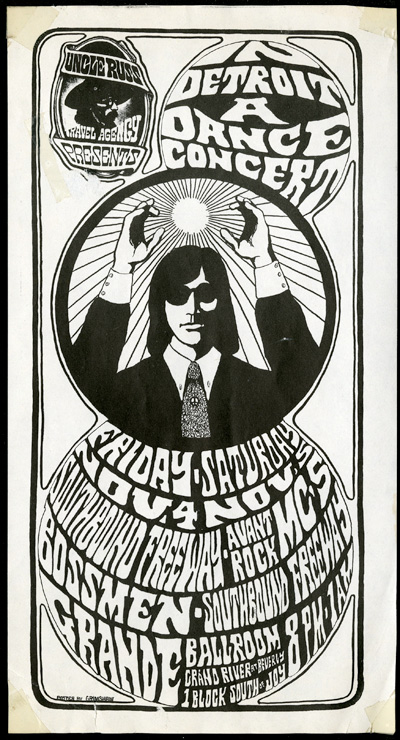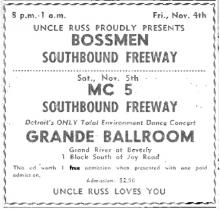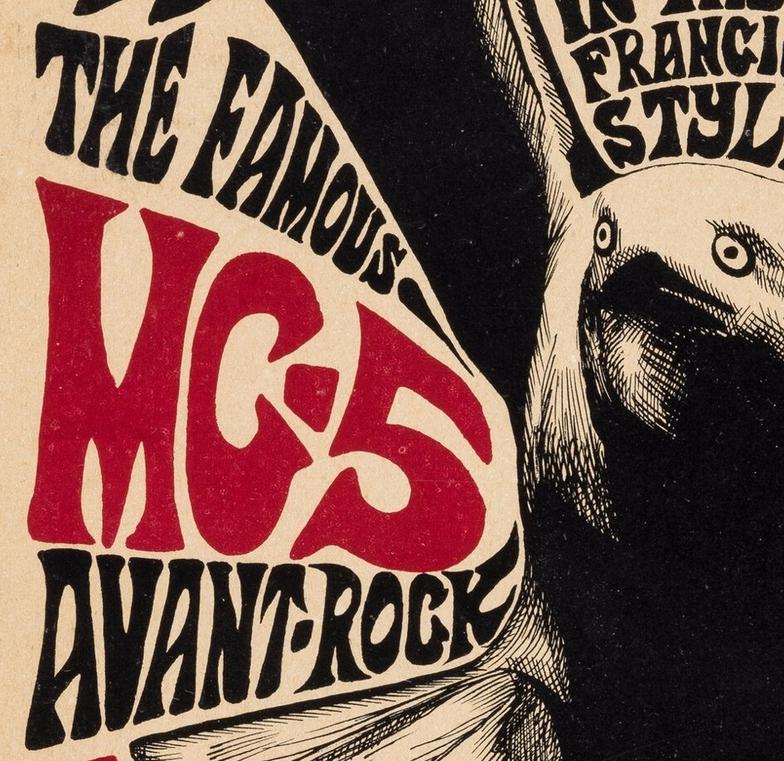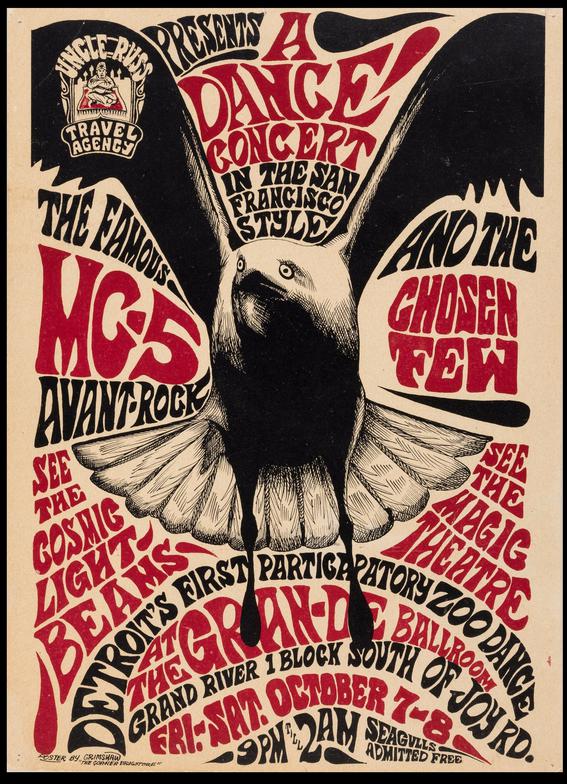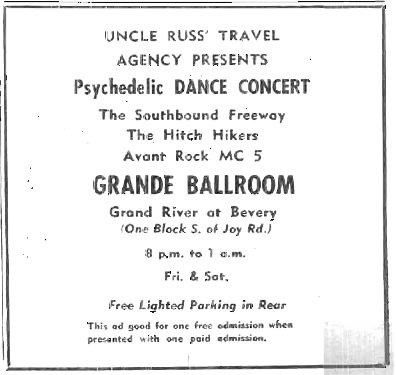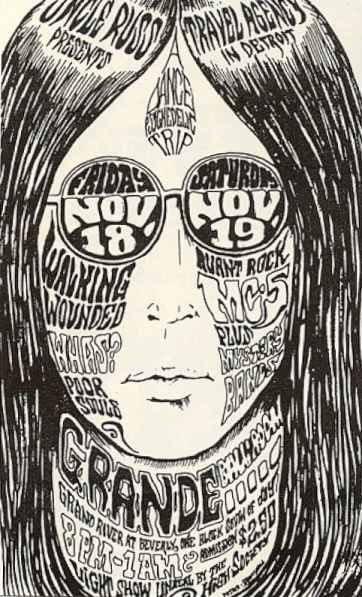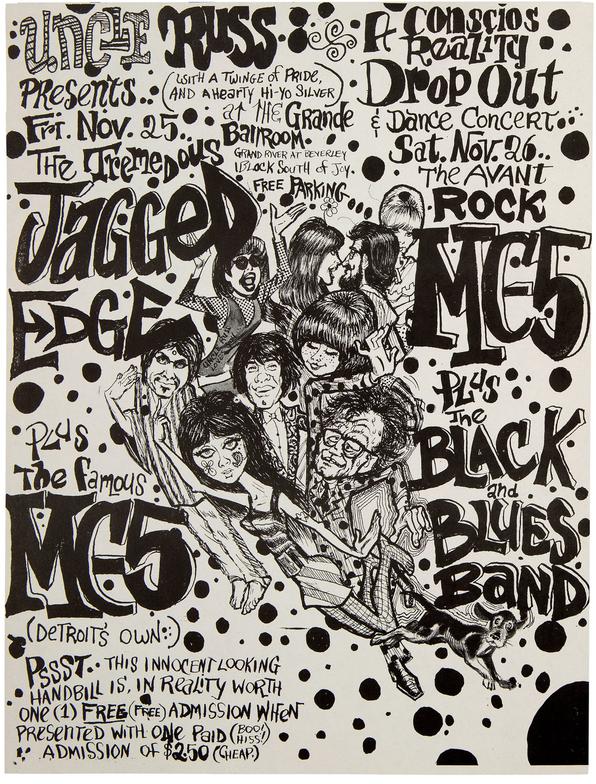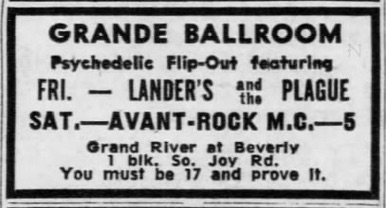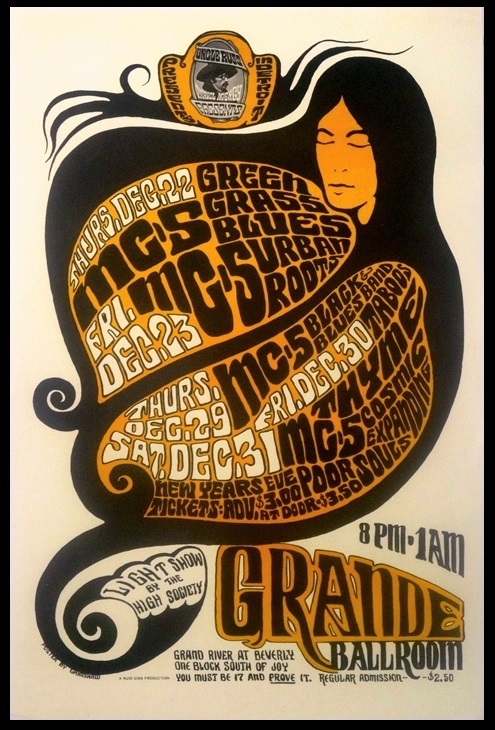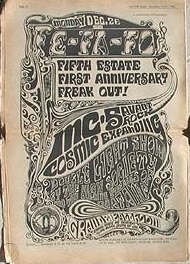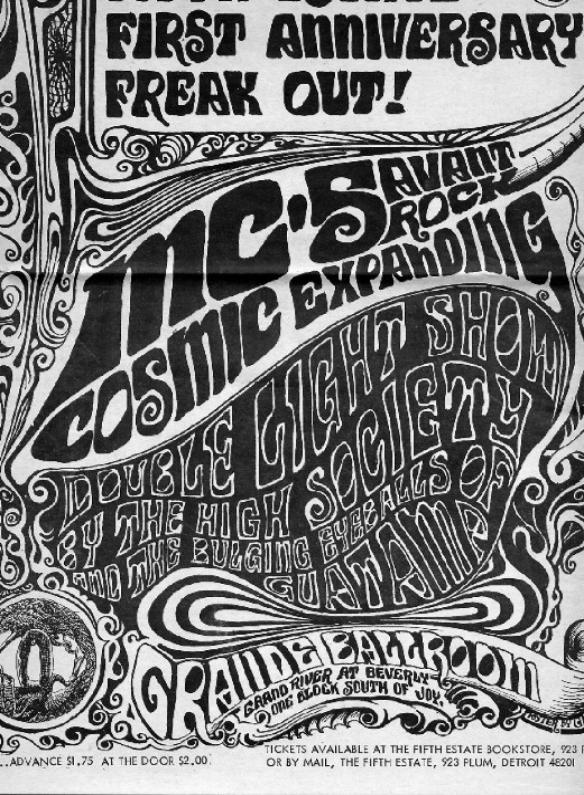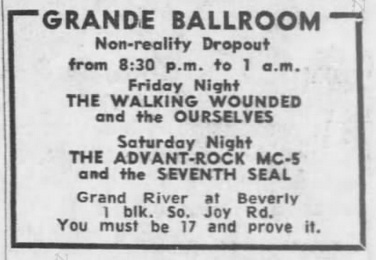Splatt Gallery
Double click here to add text.
Splatt Gallery's History of Michigan Concert Posters
The Grande Ballroom Poster History: 1966 - 1972
**********************************************************
Introduction
The Grande Ballroom in Detroit, Michigan, 1966 to 1972, is one of the most fabled and most revered live music venues, not only in Detroit but across the country and perhaps worldwide.
The definitive, authoritative, account of the Grande Ballroom is the 2016 book “The Grande Ballroom: Detroit’s Rock ‘N’ Roll Palace” by Leo Early. Leo is also the administrator of the Facebook page “Friends of the Grande Ballroom” found here - https://www.facebook.com/groups/fog1928
He is also the webmaster of “The Grande Ballroom” blog, since 2003, found here – http://thegrandeballroom.com/
A highly entertaining history of the Grande Ballroom is the documentary film, also released in 2016, “Louder Than Love: The Grande Ballroom Story” co-directed by Tony D'Annunzio and Karl Rausch.
These sources are highly recommended and are incapable of being supplanted. This document details a subset of the Grande Ballroom history – the posters and ads that were produced to promote the shows.
The Set-Up
The Grande Ballroom opened in 1928, a spectacular open room with a capacity of 1,500 on a second floor above a block of retail stores on Grand River Avenue near the intersection of Joy Road in Detroit, Michigan. A Moorish Deco design like other ballrooms, such as the Graystone and the Vanity, that were built around the same time, the “Gran-dee” became one of the most popular venues in town for big band ballroom dancing.
As the big band ballroom dancing era faded after World War II, new owners in the 1950’s attempted to revive the by-gone era by offering a “proper and wholesome” place for young people and you can guess how well that went. By 1961, as the last remaining venue of the ballroom era, the Grande was converted into a roller-skating rink and later, a storage warehouse for mattresses.
The biggest names of the times had performed on its stage, including Woody Herman, Bunny Paul, and Billy May, the brilliant composer and arranger that worked with Frank Sinatra and wrote the theme songs for many TV shows in the 60’s including The Green Hornet, The Mod Squad, The Naked City, and Batman.
Frank Sinatra – Come Fly With Me (1958)
https://www.youtube.com/watch?v=YEXWgyGkvCU
Russ Gibb, a schoolteacher in Dearborn, Michigan and a part-time radio DJ, discovered a lucrative sideline in presenting teen dances, called “Record Hops” or “Sock Hops”. These were low overhead affairs that involved renting a hall and hiring a DJ to spin records. Record companies looking to promote their artists would send them, often free of charge, to make guest appearances at these events to lip-sync their current hits. Gibb could make as much money on a Saturday night as he made in two weeks on his teacher salary. In addition, the dances put him in close contact with the teenage demographic, whom he called the “opinion makers”.
Russ Gibb became close friends with another DJ in his early radio days, Jim Dunbar, who was at WXYZ. Dunbar went to KGO in San Francisco (where he would later become famously involved in the Zodiac Killer case). In the “summer” of 1966, Gibb went out to San Francisco to visit his friend, and Dunbar had some free passes to check out this hot, new club that had been given to him by the promoter, Bill Graham.
Going to The Fillmore was a life-changing experience for Gibb. The music was LOUD, images projected on the walls in swirling colors, the dancers in wild abandon. This was definitely not the Pink Pussycat Club, or even the rough and tumble Hideouts that were back home. After the show, Dunbar took Gibb to meet Graham, who gave them a full tour and answered a barrage of questions from the excited Gibb. At one point, Graham asked, “Where did you say you were from?” “Detroit”, Gibb answered. Graham replied, “And how far away is that?” Gibb told him, “About 2,000 miles” and Graham said, “OK” and proceeded to give him the names of the lighting production outfit and other details of creating the scene.
In an interview with Michael Erlewine, Russ Gibb says that the band he saw that night at the Fillmore was The Byrds because he remembered the odd spelling of their name. The poster for that show has to be the one in the middle of the above picture since it was the only time that The Byrds played the Fillmore in 1966. Furthermore, Gibb told Erlewine that it only took him three or four weeks after getting back to Detroit that he opened The Grande, so the timing also fits for Gibb’s “summer” trip to have occurred in September 1966.
The Byrds show was the 28th one that Graham put on at the Fillmore (the poster is known as BG-28 in the collector world). This was right around the time that Graham was beginning to realize the commercial potential of these posters (all of these, by the way, were by artist Wes Wilson) and he undoubtedly must have given some to Gibb, because one of the items on Russ’ to-do list when got back to Detroit was to find a poster artist.
The Byrds – Eight Miles High (1966)
https://www.youtube.com/watch?v=4Il9q397lL0
Russ Gibb made astonishingly quick progress when he returned from San Francisco in landing a rent-to-buy deal on the old Grande Ballroom. He contacted Harvey Ovshinsky at The Fifth Estate newspaper in Detroit to ask about potential bands and Harvey referred him to the paper’s music editor, John Sinclair, who had just become friendly with a band from Lincoln Park, Michigan, a downriver community of metro Detroit, called the MC5.
When Russ first met the band they were still in their mod coats-and-ties fashion phase, but when he heard them play, he said they were EXACTLY what he was looking for. Plus, the band agreed to play for no pay at first, in exchange for being able to use the ballroom as their new rehearsal space.
In final preparations for the opening, Russ called MC5’s lead singer Rob Tyner to ask if he knew anyone that could make a poster. Rob woke up a friend of his that happened to be sleeping on his couch, named Gary Grimshaw, and told him, “Here, this is for you”.
Gary Grimshaw grew up in Lincoln Park, Michigan in a family of graphic artists, working at his uncle’s print shop in Dearborn and drawing all the time. He was the king of an “art gang” at his high school, which included friends Wayne Kramer and Rob (Tyner) Derminer, because he was the only one with a car and could transport them from the drab down-river area to the hip beatnik world near Wayne State University. After high school, Gary enlisted in the Navy and served in Vietnam, where his final tour of duty landed him in San Francisco to discover the scenes at The Fillmore and The Family Dog. He returned home to Detroit and crashed at his friend Rob’s house until something might come up.
There is probably little argument that Gary Grimshaw became the most significant psychedelic poster artist in Detroit. His work goes beyond concert posters to album art, logos, book covers, and numerous publications, including The Fifth Estate, The Sun, The Ann Arbor Sun, The Berkeley Tribe newspaper in California, and the San Francisco Oracle.
Year One
October 1966
The poster that Gary Grimshaw made for the opening night at The Grande Ballroom, October 7, 1966 is an enduring classic with lettering flowing effortlessly around the image of a seagull taking flight. The nickname “Uncle Russ” had already been bestowed on Russ Gibb, who was a good ten years older than everyone he had gathered around him, and the light-hearted “Uncle Russ Travel Agency” logo was a nod to the “Bill Graham Presents” titles on the Fillmore posters.
The poster carried a lot of text, promising a dance concert “in the San Francisco stye” with “cosmic light beams” and a “magic circus”. It was billed as “Detroit’s First Participatory Zoo Dance” and, beginning a series of gimmicks for free admission, Seagulls were “admitted free”.
It was signed “Poster by Grimshaw” and “The Corner Drugstore”.
This image was originally printed as both a poster and an 8” x 11” handbill. The poster was printed in red and black ink, while the handbill is black and white. The original poster measures approximately 13″ x 18”.
The second print poster is a hand-printed silkscreen edition of 400 that measures approximately 16″ x 24″, with the notation “© 1966, 1993 Gary Grimshaw” in the lower left corner, and “Printed by Ghetto Press – Detroit”.
A third print poster measures approximately 14″ x 19″. The notations “© 1966, 1993, 2003 GARY GRIMSHAW” and “Third edition under license to Levi’s Vintage Clothing” appear in the bottom margin on the left side. Gary Grimshaw signed and numbered 297 copies of this printing.
The bands that performed on the opening weekend, October 7-8, 1966, were the MC5, the Chosen Few, and The Wha? . The MC5, true to their agreement with Russ Gibb, would use the Grande as their rehearsal space and in effect became the “house band”. They performed more than 100 shows at the Grande during the Grande’s rock and roll years, an order of magnitude well above any other act.
Although the roots of the MC5 go back to 1963, the final line-up had been together for only about a year when the Grande Ballroom opened. Before the year was over, they would make their first recordings, resulting in their debut single, released in March 1967.
The MC5 – I Can Only Give You Everything (1967)
https://www.youtube.com/watch?v=uBnUeZY2lrI
A close-up of the “Uncle Russ Travel Agency” logo on the first Grande Ballroom poster, with a genie on a flying carpet. It would not be used again.
Shown above are all three official printings of Gary Grimshaw’s “Seagull” poster (not including the original black & white handbill). Bootleg reprints have been sold as originals, these do not have the “The Corner Drugstore” inscription under Grimshaw’s name, and “Poster by Grimshaw” does not have the flourish of the original which has “Poster” underlined and a sweeping “w” in Grimshaw’s name.
Not only did artist Gary Grimshaw create the first poster for the Grande Ballroom, but he also provided a first-hand account of the venue’s first weekend, in extensive detail, published in the October 16-30, 1966 issue of the Fifth Estate newspaper, titled “Detroit Freaks Out With First Participatory Zoo Dance”.
The above scan should be quite legible, so you can hear it in Gary’s voice. He describes the performances by the Chosen Few and MC5, the opening night audience, and details of the light show, which he co-created, humbly described as “put together by the High Society, a group of artists, poets, writers, and film makers from Detroit”.
He certainly clears up the question of whether the Chosen Few opened the first show, a question that comes up in the following narrative, which we will keep in place for its interesting aspect on the role of memory.
But GARY WAS THERE, and for the five minutes or so that it takes to read his words, he is here again.
There was some question as to whether the Chosen Few appeared at the opening night show as they were in the process of breaking up at the time, although Gary Grimshaw’s review of the opening night confirms the Chosen Few appearance. Daniel O’Connell, with the band The Wha?, tells the story of being enlisted by Russ Gibb to fill in as the opening act. A story that will make modern day poster collectors cringe:
"Dempster (fellow band member) and I met Russ Gibb at Northland about one or two weeks before the Grande's first night. He had reams and reams of those "Seagull posters". Gibb was handing them out at Northland, he hustled us, or we hustled him, into being an opening act for the first night ....perhaps it was the second night a Saturday...... in any event it was to my recollection because the Chosen Few had broken up and canceled the show...."
"So, Russ Gibb gave us heaps and heaps of those "Seagull" posters..... so many I covered my entire bedroom wall with them...... still had stacks of them to staple in the basement, write notes to my parents on, paper airplanes....... not one of them survived! Had to pay 50 bucks for a re-issue by Gary Grimshaw two years ago!" (written in 1999).
Postscript to the opening night at The Grande Ballroom.
Posters announcing “The Grande Ballroom Opening – Friday Sept. 16” with a simple drawing of a bugle were found. Coincidentally, September 16th did fall on a Friday in 1966 (as it had in many years since the twenties), prompting stories that the original opening had been delayed.
However, as described above, Russ Gibb was having his mind blown by The Byrds at The Fillmore in San Francisco on September 16, 1966, and Gibb has explained that they had found a box of these when they took over the ballroom. They have been identified as being printed in 1955 during one of the ballroom’s periodic resurgences. Gibb has said that they just pinned them up all over the walls and they eventually disappeared. The final vestiges of the glory days of the ballroom era of the past, ripped down and scattered to the wind.
At the time of the opening rock and roll show at the Grande, the extremely successful ABC-TV series “Batman” was starting its second season, and one the old ballroom’s long-ago stars, Billy May, had another of his greatest hits.
Billy May – Batman Theme (1966)
https://www.youtube.com/watch?v=GewJBonH2EQ
The second weekend of the Grande Ballroom, October 14-15, 1966, and the second poster by Gary Grimshaw. It is also the premier of Grimshaw’s “Light Show by the High Society”.
Sharing the two-night billing with the house band, the MC5, were the Woolies from Lansing, Michigan. The concert database also has the band Southbound Freeway appearing on the second night.
The Woolies were the recent winners of the Vox Battle of the Bands at the Michigan state fairgrounds. First prize was a trip to Hollywood for a recording session where they cut a version of Bo Diddley’s “Who Do You Love” which became a regional hit.
The Woolies were the house band at a roadhouse outside Lansing, called The Dells, where they had the opportunity to serve as the backing band for a touring Chuck Berry. Berry liked the band so much that whenever he was touring the Midwest, he would say, ”Get me The Woolies”. They ended up touring with him for years and Chuck Berry’s 1971 album, “San Francisco Dues” was recorded with The Woolies at their Lansing Sound studio.
These two nights appear to have been the only time that the Woolies performed at the Grande Ballroom.
This image was printed only as a poster.
From: ClassicPosters.com:
“This scarce poster was used for the second Russ Gibb show held at the Grande Ballroom. Gary Grimshaw designed it using pleasing green and magenta colors. It features a long-haired skull wearing a bandana. This poster shows up occasionally, but it is far from common. The print runs on these early Grande posters were very small, and this is no exception.
“The original poster was printed on white stock and measures approximately 15½″ x 20″.” It appears there were no handbill versions.”
A 13” x 19” lithograph reproduction was printed in 2008 as a “Second Edition”.
The Woolies – Who Do You Love (1966)
https://www.youtube.com/watch?v=SfgmaNPJXZo
Gary Grimshaw’s second poster for the Grande Ballroom introduced a new Uncle Russ logo that used a picture of General George Armstrong Custer, of “Custer’s Last Stand”, wearing Russ Gibb’s glasses. It would be used on his next dozen posters.
General George Armstrong Custer (1839 – 1876)
Coinciding with the second weekend of the Grande Ballroom, October 14-16, 1966, a club in Ann Arbor, Michigan called the Fifth Dimension began its operation with three “sneak preview” shows and a Grand Opening with Mitch Ryder & the Detroit Wheels on October 22nd. Founded by Mickey Kress, the Fifth Dimension would be the venue for the first Michigan appearances by The Who, the Yardbirds, and the Jimi Hendrix Experience.
OMG! That’s what our plucky teen scene reporter, Loraine Alterman, would say today. In her near-breathless review of the Grande Ballroom published in the October 21, 1966 edition of the Detroit Free Press on the third weekend of operation, poor Loraine cannot contain her excitement over the new venue, going so far as to make up her own words (op-pop?) and sound effects (Zow!?). Here’s some of what she had to say:
"Pow! Wham! Bang! Zow! That's how the new op-pop scene at the Grande Ballroom hits you. No doubt about it - it's the grooviest, most exciting teen night spot in town."
“Dig the scene. You enter by walking up a wide staircase. On the landing a ticket taker is perched on a motorcycle. Next to him are pots of phosphorescent make-up. Paint a big flower on your face or stripes on your hands. When you get inside, they’ll glow in alive pinks, greens, (and) blues.”
“Step up a few more stairs. The wild vibrant sounds of today’s music hit you…and hits with the force of a blast furnace. To borrow a phrase from Murray the K, it’s what’s happening baby.”
“Huge multi-color bubbles and amoeba-like shapes are changing, rolling, dancing on the walls. Fantastic! OK, that’s the walls. Suspended from the ceiling are two movie screens. On them are old-time silent films, new-time artsy films, slides on top of films. Like wow!”
“Step into another area of the ballroom and you’ll be flickering just like you are in one of these ancient silent movies. What is it? A strobe light area and the strobe produces these zany effects. I don’t mean to sound like a press agent for the place, but…if you’re 17 or over and don’t hit the Grande…you are out of your skull.”
By the way, Loraine Alterman (photo above) whom we will see again, has quite a fascinating life story.
Photos from inside the Grande Ballroom by Detroit Free Press photographer Fred Plofchan that accompanied Loraine Alterman’s story in the October 21, 1966 edition of the paper. The shots would have been taken on the previous weekend, the second weekend of operation for the Grande, October 14-15, which was also the premier of Gary Grimshaw’s “Light Show by the High Society”. Grimshaw can be seen on the right-hand side of the photo in the lower left.
The third weekend of the Grande Ballroom, October 21-22, 1966, and the third poster by Gary Grimshaw. This image was printed only as a poster. Sometimes referred to as “the Zebra Man”, the original poster measures approximately 17″ x 22″. No handbill version was made.
A 13” x 19” lithograph reproduction was printed in 2008 as a “Second Edition”.
The MC5 and the Prime Movers from Ann Arbor performed both nights. This was only the second gig for the Prime Movers since drummer Iggy Osterberg had departed, replaced by Tom Ralston and soon after, by Jesse Crawford, future “Brother J.C.”, founder of Zenta “religion” and MC for the MC5.
Although Gary Grimshaw’s “Zebra Man” poster only lists the MC5 and the Prime Movers Blues Band, the line-up for the weekend also included Southbound Freeway, Chosen Few, the Gang, and The Wha?
People often ask; where do these artists get their crazy ideas? The answer is from LIFE (magazine).
Coincidently, or not so coincidently, both Stanley Mouse and Gary Grimshaw used the cover photo from the December 6, 1954 issue of LIFE magazine for their next posters.
Mouse and Alton Kelley used it for the Family Dog’s 13th Floor Elevators shows at the Avalon Ballroom in San Francisco, California, Sept 30/Oct 1, 1966, and Grimshaw used it for his third poster for the third Grande Ballroom show three weeks later.
The word was starting to get around. There had been a brief announcement in the newspapers before the opening, but consensus is that only about 60 people attended the opening night at The Grande Ballroom. It is also said that attendance doubled the second night, but that’s still not much larger than a decent keg party.
For promoting the third weekend, October 21-22, 1966, a couple of ads appeared, believed to have been drawn by the MC5’s lead singer, Rob Tyner.
Although Gary Grimshaw’s “Zebra Man” poster only listed the MC5 and the Prime Movers Blues Band, Tyner’s flyers were billed as a “Six Band Freak-Out”, the line-up included the MC5, the Prime Movers Blues Band, Southbound Freeway, Chosen Few, the Gang, and The Wha?
Without mentioning the name, the Grande Ballroom, this newspaper ad is for the third weekend at “Detroit’s first Total Environment Psychedelic Dance Concert”, October 21-22, 1966, with the six-band line-up of the MC5, Prime Movers, Chosen Few, the Wha?, the Gang, and Southbound Freeway.
Poster by MC5 lead singer Rob Tyner for Weekend #4 at the Grande Ballroom, October 28-29, 1966. It was Tyner’s first poster for the Grande, not counting the two ads for Weekend #3, there was no Gary Grimshaw poster for the fourth weekend.
The shows were billed as “The First Annual Mystic Rites of Autumn Freak-Out, Masked Ball and Monster Rally”. Attendees were urged to come in costume, with prizes for the best costumes. There was also a note to “see Thursday’s Collegian for another bread saving offer”.
The original poster/handbill measures approximately 8″ x 11″. No other editions are known.
The bands for the fourth weekend were the MC5 and Southbound Freeway on the first night, with Southbound Freeway and the Chosen Few for the second night.
This ad for Weekend #4 at the Grande Ballroom (October 28-29, 1966) that doubles as a coupon (one free admission with one paid), which must be the “bread saving offer in the Collegian” mentioned on Rob Tyner’s poster. The ad artwork, also by MC5 lead singer Rob Tyner, is more artistic than his poster. “Rick’s Fun Reality Orientation” is an unknown reference.
An ad in the Michigan Daily newspaper in Ann Arbor for the above shows (October 28-29, 1966) at the Grande Ballroom.
The fifth weekend at the Grande Ballroom, November 4-5, 1966, was promoted with Gary Grimshaw’s fourth poster and featured a band from Saginaw, Michigan called The Bossmen, featuring guitarist and singer, Dick Wagner.
This image was printed as both a poster and a black and white handbill. The poster measures approximately 11″ x 22″, while the handbill measures approximately 6″ x 11″.”
From ClassicPosters.com:
“Known as the "Mod-Man", this poster is very scarce and seldom shows up for sale. Most of these we have seen display varying degrees of over inking. The black-and-white handbills for this show are excessively rare and there are only two genuine examples known.”
The Bossmen opened for Southbound Freeway on the first night and Southbound Freeway opened for the MC5 on the second night.
The Bossmen – Baby Boy (1966)
https://www.youtube.com/watch?v=vwr4fn5X0wg
The extremely rare black-and-white handbill by Gary Grimshaw for the fifth weekend at the Grande Ballroom, November 4-5, 1966.
A newspaper ad for the fifth weekend at the Grande Ballroom, November 4-5, 1966 that doubles as a pay-one, get-one admission free coupon.
The Grimshaw “flourish” signature on the original Grande Ballroom “Seagull” poster.
For the sixth weekend at the Grande Ballroom, November 11-12, 1966, the poster looks hastily assembled, re-using Gary Grimshaw’s image from the week before with lettering attributed to Rob Tyner (counted as Tyner’s third poster). On Friday night, the bands were the Hitch Hikers soon to become Thyme) and Southbound Freeway and on Saturday it was a “surprise band” with the MC5.
The text states “Still Detroit’s Only Mind-Manifesting Dance Concert”, with “The power of OM surrounds you” and “Tyner Power” sideways after “MC-5”.
The original poster/handbill measures approximately 8″ x 11″. No other versions are known to exist.
The Hitch-Hikers were a band from Kalamazoo, Michigan, who soon after this show, enlisted bass player Al Wilmot from the Kalamazoo band, The Monuments, moved to Ann Arbor, signed on with Jeep Holland’s A-Square Records, and changed their name to The Thyme.
The Hitch-Hikers – You’re the One (1964)
https://www.youtube.com/watch?v=Afs1FJaH7GM
A newspaper ad that doubles as a BOGO coupon for the sixth weekend at the Grande Ballroom, November 11-12, 1966.
The poster for the seventh weekend at the Grande Ballroom, November 18-19, 1966, was Gary Grimshaw’s fifth poster, a drawing of a gender-nebulous face. The bands that weekend, for the first night were Walking Wounded, Poor Souls, and The Wha?. On the second night, it was the MC5 and a “mystery” band. Like the “surprise band” the week before, the mystery band remains unknown.
This image was printed as an 8” x 11” handbill in two versions; on thin white stock and on coarse grey/green stock.
The Thanksgiving weekend, November 25-26, 1966 was the eighth one at the Grande Ballroom and was the third poster (not counting ads) that was made by MC5 lead singer, Rob Tyner, whose drawings were becoming quite good. Billed as “A Conscious Reality Drop Out & Dance Concert”, the Jagged Edge opened for the MC5 on Friday night, with the Black & Blues Band opening for the MC5. on Saturday. The handbill also doubled as a buy one, get one free admission coupon.
The original handbill measures approximately 8″ x 11″.
It was the first appearance at the Grande for the Detroit high school band, The Jagged Edge, who would perform at the Ballroom close to 30 times. Led by Dave “Stoney” Mazur, the Jagged Edge, who started out playing biker parties, were amazingly heavy right from the start, and Mazur’s wild stage antics were a major inspiration for Iggy Pop, who had to frequently one-up him as they followed them in shows.
The Jagged Edge – Can’t Find the Key (1968)
https://www.youtube.com/watch?v=-BPS4kcx2wY
Newspaper ad for the ninth weekend at the Grande Ballroom, December 2-3, 1966, with the misspelled “Psychodelic Flip-Out” and a coupon for free admission. There does not appear to have been a poster made for this weekend. On Friday night the Southbound Freeway performed with the Hearde and on Saturday it was the Poor Souls and the Cosmic Expanding Blues Band. It was the first weekend that the MC5 did not perform at least one of the nights.
For the tenth weekend at the Grande Ballroom, December 9-10, 1966, the MC-5 were back, and Rob Tyner produced his fifth poster, a detailed and wordy comic strip equating a trip to the Grande to an acid trip. The Jagged Edge with Ourselves performed on the first night with MC5 and the Kynde on the second night.
The original handbill measures approximately 8″ x 10″.
A second, seldom seen, ad by MC5 lead singer Rob Tyner, a variation of the final panel in Tyner’s comic strip poster, for the tenth weekend’s shows at the Grande Ballroom in Detroit, Michigan, December 9-10, 1966, with the Jagged Edge, Ourselves, the MC5 and Kynde.
This is the best image we can find of any poster for Week 11 at The Grande Ballroom, December 16-17, 1966. It looks like Rob Tyner (presumably) must have been very, very stoned when he did it. Unfortunately, this seems to be Tyner’s last poster, his seventh, for the Grande.
The poster is impossible to read, but from the Concert Database, the bands were the Landeers, the Plague, MC5, and The Wha?.
The Landeers were a high school band from Livonia, Michigan that managed to get on record backing up singer Ronnie Putirka on some songs recorded at United Sound in Detroit, circa 1964. The bass player for The Landeers, Jim Bugnel, became a member of The Flaming Embers.
Ronnie Putirka - Don’t Shake Me Down (1964)
https://www.youtube.com/watch?v=7QzJuSNrMdg
Newspaper ad for Week 11 at The Grande Ballroom, December 16-17, 1966. Much more legible than Tyner’s poster, we can see the Landeers were with the Plagues on Friday night, with the MC5 on Saturday. The Concert Database also has The Wha? opening for the MC5.
The Plagues were a band from Lansing, Michigan that had formed in 1964 and were soon to become Plain Brown Wrapper.
The Plagues – I’ve Been Through it Before (1966)
https://www.youtube.com/watch?v=FUKNwGi8nIc
Gary Grimshaw returned after a four-week hiatus to create this poster (his sixth) for the Grande Ballroom, covering both of the final two weekends of 1966, (weekends #12 and #13) with five shows, December 22-23 and December 29-31. The MC5 headlined four of them, with openers Green Grass Blues, Suburban Roots, Cosmic Expanding, and the Black and Blues Band. The one show without the MC5 was December 30, with the Taboos and Thyme.
As with all of the Grande Ballroom posters, Russ Gibb would give stacks of these to an army of local teens with the promise of free admission to the show if they would distribute the posters throughout the neighborhood.
Two of his favorite enlistees were the Finly brothers, Jon and Steve, who established a poster distribution hang-out in the parking lot of the McDonalds restaurant on the corner of Grand River and Fenkell (5 Mile). Gibb would promote the location during his radio show on WKNR, dubbing the brothers as “the McDonalds Drop-Outs” and enticing kids to join in on the scene as a great place to pick up girls (and free posters).
The original poster measures approximately 15″ x 22″. No other versions were issued at the time, however Grimshaw released a in 2011.
An additional show was slipped into the ending week of 1966, to celebrate the one-year anniversary of The Fifth Estate newspaper, held the night after Christmas, December 26, 1966. The poster for the “Fifth Estate First Anniversary Freak Out!” is credited to Gary Grimshaw, his seventh. The bands were the MC5 and the Cosmic Expanding.
Newspaper ad for the Fe-Fa-Fo (Fifth Estate First Anniversary Freak Out) at the Grande Ballroom, December 26, 1966, by Gary Grimshaw, which was a variation of the top portion of the full poster that he had made for the event.
A cleaner version of the bottom portion of the poster for the Fifth Estate First Anniversary Freak Out! on December 26, 1966.
A story in The Tower, a weekly student newspaper at Grosse Pointe High School in Grosse Pointe, Michigan, about a group of students who had formed the band Cosmic Expanding Blues Band, noting their appearances at the Grande Ballroom.
The group’s lead singer and harmonica player James Montgomery would go on to a successful solo career. We also believe that he made the posters for the group and associated shows, three of which we have seen earlier.
A fantastic find, we don’t know the source, but it appears to be a newspaper ad, you can see a border line on the side that was probably around another ad on the page.
A very cool illustration by James Montgomery that describes the final weeks of 1966 at the Grande Ballroom, it has the five shows that were on the Gary Grimshaw poster; MC5 with Green Grass Blues on December 22, MC5 with Urban Roots on December 23, MC5 with Black & Blues Band on December 29, Thyme with Taboo on December 30, and the New Year’s Eve show of the MC5 with Poor Souls and Cosmic Expanding on December 31, 1966.
The art has a shout-out at the bottom to LeMar, the earliest marijuana legalization advocacy organization, formed by Allen Ginsberg in NYC in 1965.
A newspaper ad for the fourteenth weekend at the Grande Ballroom, January 6-7, 1967.
We have never found a poster for the Grande’s first weekend of the new year, its 14th to date, on January 6-7, 1967. A newspaper ad bills it as a “Non-reality Dropout”, which seems to beg out for a poster somewhere. Groups that performed were the Walking Wounded, Ourselves, Seventh Seal, and MC5.
The Grande Ballroom Poster History - continues - HERE







